Visit 12 most famous, beautiful and interesting bridges in Prague – travel guide including things to see, history and fascinating stories.
My little travel guide to the central Prague’s Bridges with their history and fascinating stories from when they were built.
Whilst Charles Bridge is the most famous Prague bridge, there are other bridges in the historic centre of Prague that are definitely worth exploring.
Most of Prague’s bridges are named after famous people and all have a fascinating history, which helps to paint a picture of how Prague has developed through the centuries.
I have also included things you can see around the bridges once you are there, including my favourite places and a few hidden gems too.

How many bridges are in Prague?
There are a grand total of 18 bridges in Prague across the Vltava river.
The oldest bridge is the one that everyone knows – the Charles Bridge in the centre of Prague.
One of the most recent bridges is a modern bridge connecting Stromovka Park with the Troja side of the river with its ZOO, Botanical garden, vineyard and a picture gallery in a magnificent chateau. The Troja bridge was built in 2014 and it was just recently re-built again and reopened.
The last bridge is a pedestrian bridge between Karlin and Holesovice (close to Hlavka’s Bridge). It’s a great shortcut between the Holesovice Trznice (former Meet Market) and the Karlin trendy area of Prague.
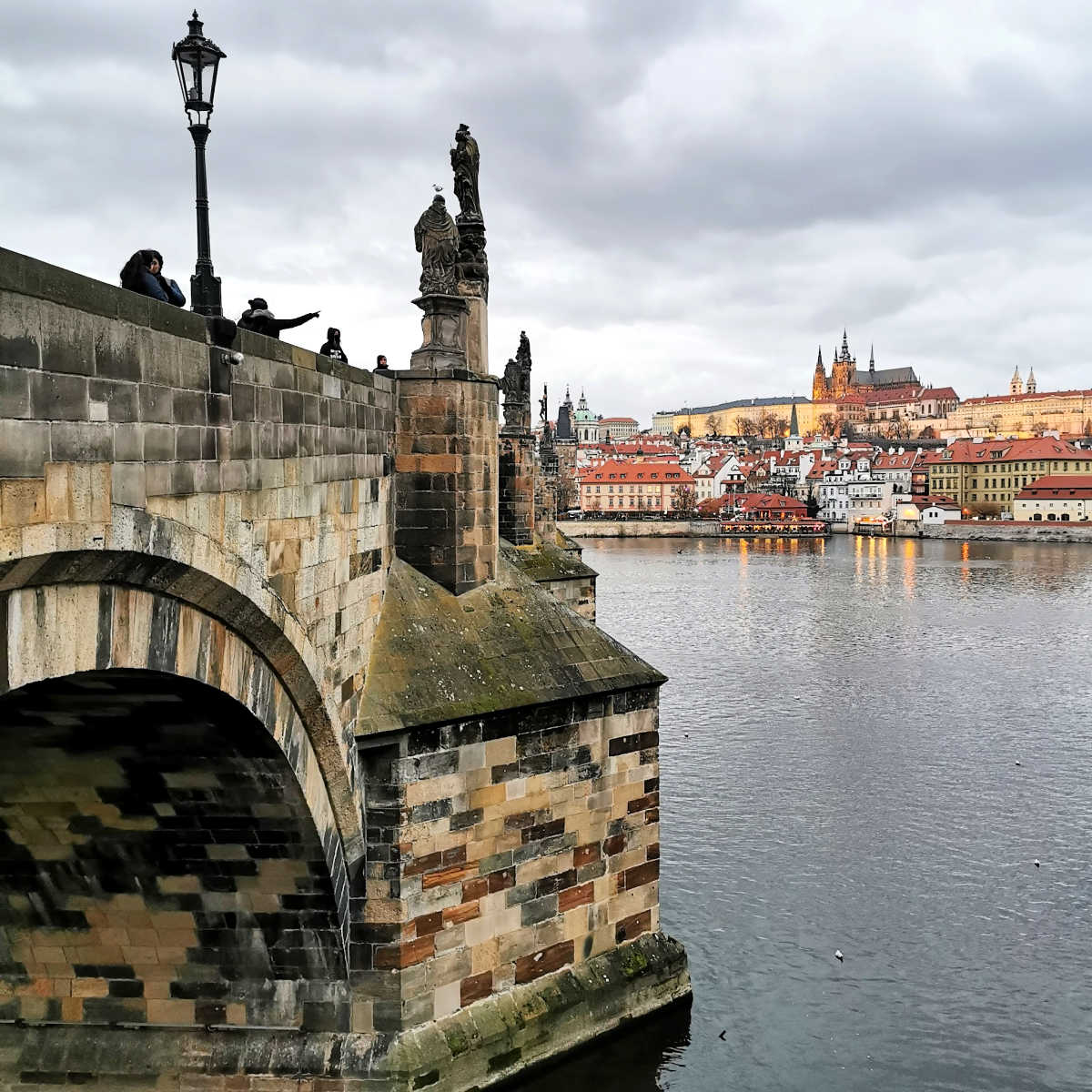
Where is the best view of the Prague bridges?
Well, you can’t see all of the bridges at the same time, but you get to see quite a few beautifully lined up from a great viewpoint on Letna Park close to the Hanau Pavilion (it’s a pretty building in one corner of the park, which is also a restaurant)
It’s a magical place to watch the sun go down any time of the year and there is lots more to do than just watch the beautiful view of Prague.
Another good view is from the Petrin Lookout Tower from the top of Petrin Hill or from the towers at each end of the Charles Bridge (you will get the best view of Charles Bridge from there).
Another excellent view is from the garden of Kramarova Villa (in Letna area, but closer to the Prague Castle than Hanau Pavilion on the top of the hill), but it’s only open during special Czech public holidays, as it belongs to the government and it’s normally used for state visits, meetings and press conferences.
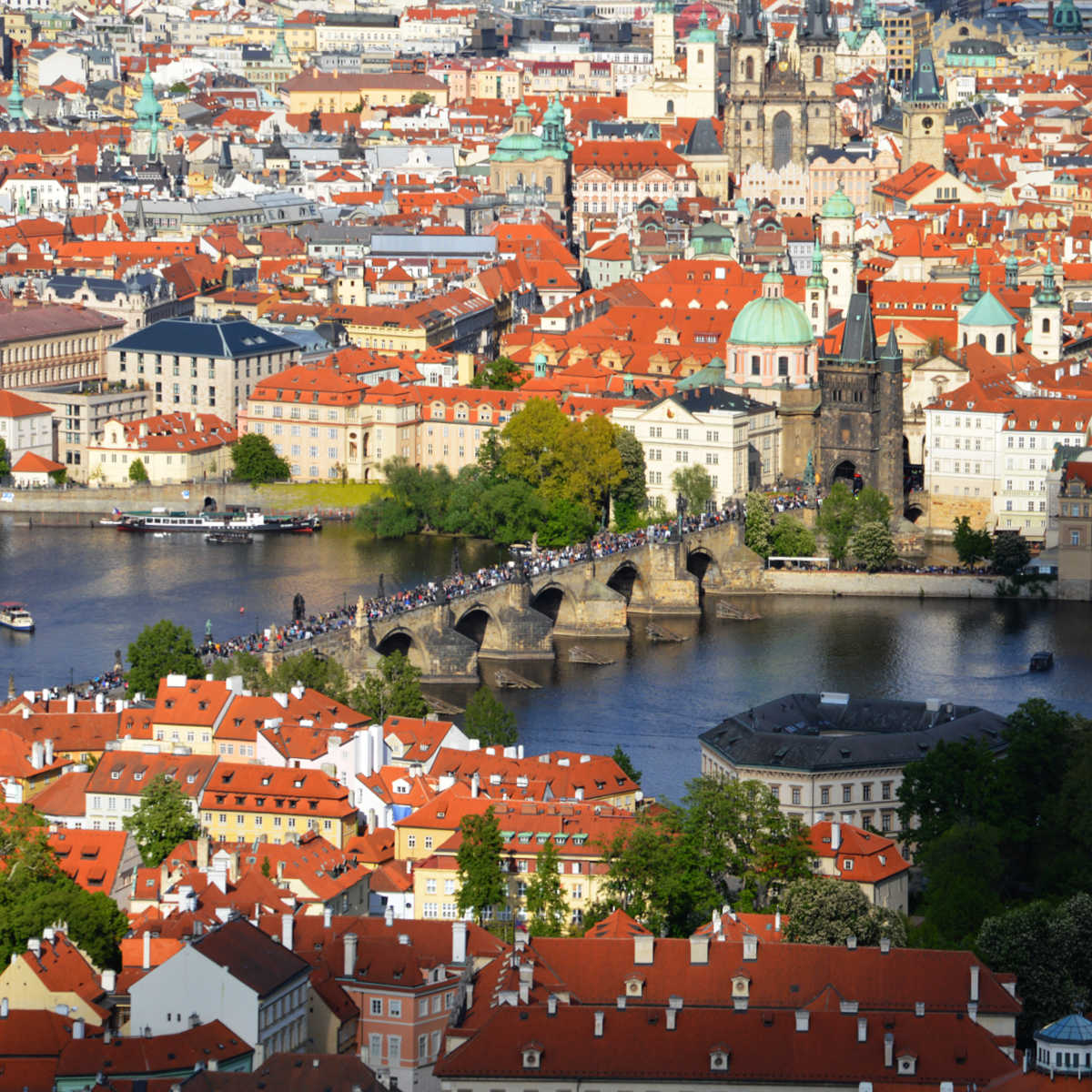
What is the most beautiful bridge in Prague?
The most beautiful bridge without a doubt is Charles Bridge with its decorative statues, cobbled stoned surface and gothic towers at each end of the bridge. From one side you have a wonderful view of Prague Castle and Hradcany and the other side has picturesque churches, towers and beautiful buildings. No matter where you stand on the bridge you can get a good view of something magical in the background.
Come any time of the year and Charles Bridge will charm you – in the summer with the sun setting behind the Prague Castle or in the winter when the bridge and statues are dusted with snow.
The most famous bridges in the centre of Prague

Palacky’s Bridge (Palackeho Most)
Palacky’s Bridge was built at the end of the 19 century and is the 3rd oldest bridge over the river Vltava (counting only existing bridges). It was built to connect the then-industrial (but very prosperous) Smichov with Prague.
The Ringhoffer’s factory (the main Smichov employer and producer of cars, trams and heavy industry elements) even supplied material to build the bridge. I found out that the bridge was originally painted in bright colours, but unfortunately, once the colours faded, they were not restored.
There were once statues on this bridge, but because they were damaged in the second world war bombing, they were later moved to Vysehrad Castle Grounds Park on top of a nearby hill. You can still see them today – they were inspired by Czech folk stories and they are the statues of Ctirad, Sarka, Libuse, Premysl and others.
It was also the first bridge that in 1883 had the first horse-drawn tramway line.
My favourite fun fact (apart from the tram, of course!) is that Albert Einstein would have used this bridge on his daily commute to his university. He studied in Prague in 1911-12 and lived in Smichov.
Travelling on the tram (10, 16, 5 and others) you get a view of Prague Castle and the town on one side and Vysehrad and the Vysehrad Railway Bridge (which takes trains from the Prague Main Train Station to Smichov Train Station) on the other.
What to see around
- Palacky Square – large statue of Palacky (writer and thinker), park and walk leading to Emauzy
- Emauzy Monastery – small monastery that was bombed during WW2 and rebuild
- Naplavka Farmer’s Market – one of the many farmer’s markets in Prague

Jirasek Bridge
Jirasek’s bridge is the next one on the Vltava river and it’s a fairly modern one. It was built in 1930s originally for the tram line, cars and pedestrians, but pretty much straight away the tram line was removed as it wasn’t needed. Later on, the bridge carried the only trolley bus line that was connecting both sides of the Vltava river.
Since there is no tram line on this bridge now, you probably won’t use it for crossing the river, but if you wanted to, this bridge is the one closest to the famous Dancing House of Ginger & Rogers.
When the plans for the bridge were drawn, there was a baroque house (on the Smichov side) that was in the way of the new bridge pathway. The house was apparently built by the famous Killian Ignac Dientzenhofer. There were plans to move the house about 110 metres to one side and rebuilt it there.
Unfortunately, no insurance company wanted to take this on as a job in case there were problems and damage caused to the house whilst it was being moved. The worse thing is that because of that the house was just demolished instead!
The bridge also contained secret hollow pipes in a couple of the bridge pillars, which were designed so that the bridge can be blown to pieces if needed. These hollow pipes were filled in by the German occupying army because they were worried that the Czech people might use it against them to sabotage their invasion.
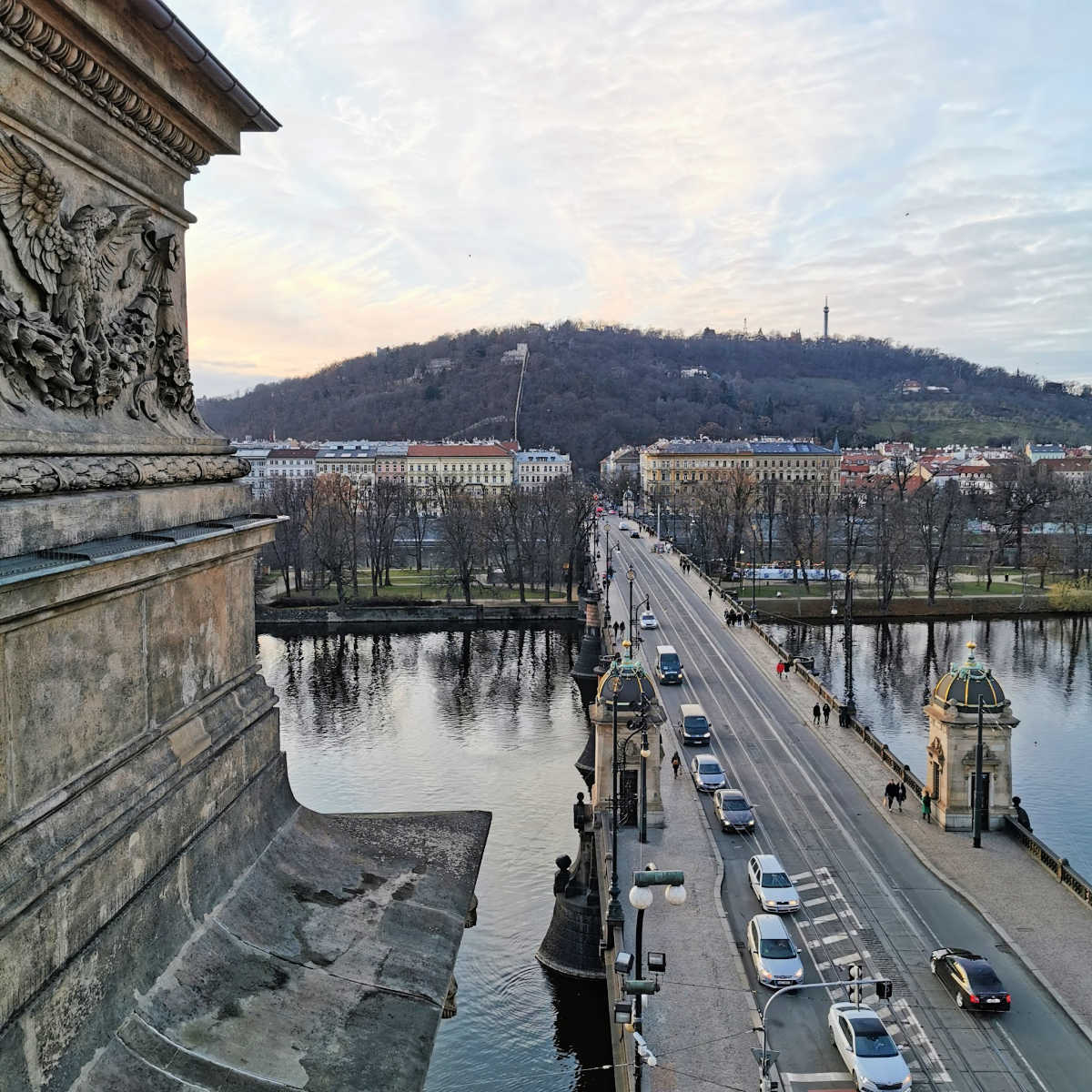
The Legion Bridge
You are most likely to come across the Legion Bridge on your visit to Prague, because it’s the one that’s the closest to the National Theatre (the one with the golden roof) and connects Ujezd (where you come down from Petrin or use the Petrin Cable car) and the theatre side of Prague. It has a great view of the Charles Bridge and Prague Castle.
There are plenty of trams going across and if you use the no.22 to go to Prague Castle from the centre, you will travel over this bridge too.
I often walk across when I visit Shooter’s Island, which is only accessible from the middle of the bridge.
The Legion Bridge was opened in 1901 and the four little houses (two on each end of the bridge) were originally for collecting toll money for crossing the bridge. But the current bridge is the second one in this place. The first bridge was built in 1841 and it was the second bridge (after Charles Bridge) to be ever built in Prague. If you’ve ever seen an old picture of Prague with what looks like a Tower Bridge in London, then that’s what the first bridge looked like.
I love the story of its founder – Karel Chotek – who was keen on making the second bridge a success and after it was built he would come down and count the amount of people crossing the bridge. The problem was, that that year the Vltava River froze over and as people didn’t want to pay the bridge toll they were crossing the river on the foot on the ice!
My super cool photo of the bridge (even if I say so myself!) is from the top of the National Theatre roof, where you can get the perfect view of the bridge, the famous Petrin Lookout Tower, Petrin Hunger Wall and the Prague Castle.
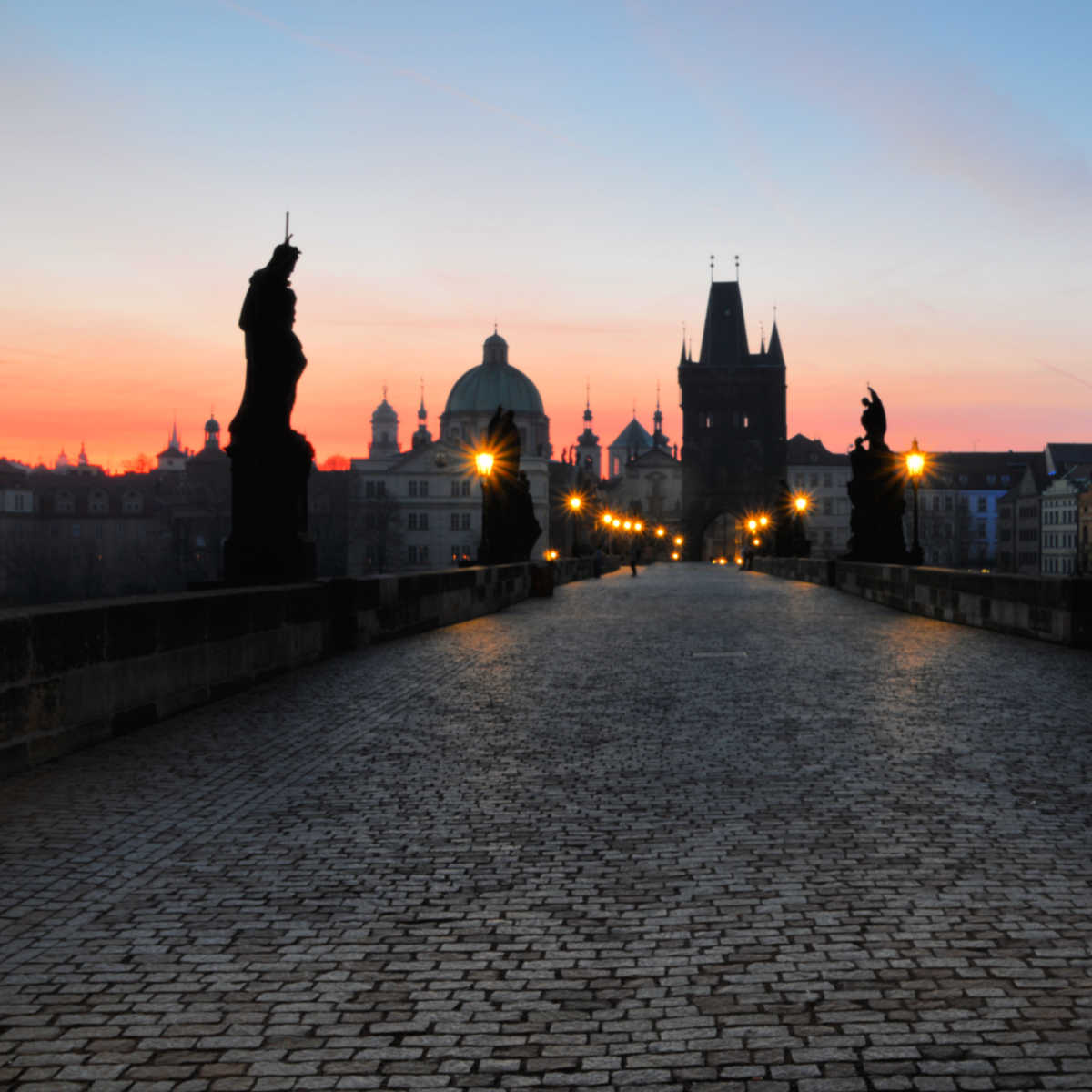
Charles Bridge
Well, where do we start with the most famous bridge in Prague? It’s the one attraction that you simply have to visit at least once on your trip to Prague. It’s the most talked-about one in the travel guides, the most photographed one and the most crowded one!
If you want to avoid the large crowds, plan your walk across very early in the morning (by early I mean before or around sunrise, which is 6-7.30 am in the winter and 4-5.30 in the summer). Even then I’m sure you won’t be the only person there!
You’ll meet photographers, some with serious camera gear, some with just their phones, a few drunken tourists that never made it to bed and occasionally foreign tourists taking wedding photos!
It’s not that they just got married, but apparently, Charles Bridge was featured in a popular Japanese or Chinese film where the main characters got married in Prague on the bridge – hence everyone wants to take photo there!
Since there is so much to say about Charles Bridge you’ll find more details in my next blog post. I’ve also put together for you a handy guide on how to take the best photos of Charles Bridge, which also takes you on a short walk around the bridge to explore it more.
READ MORE
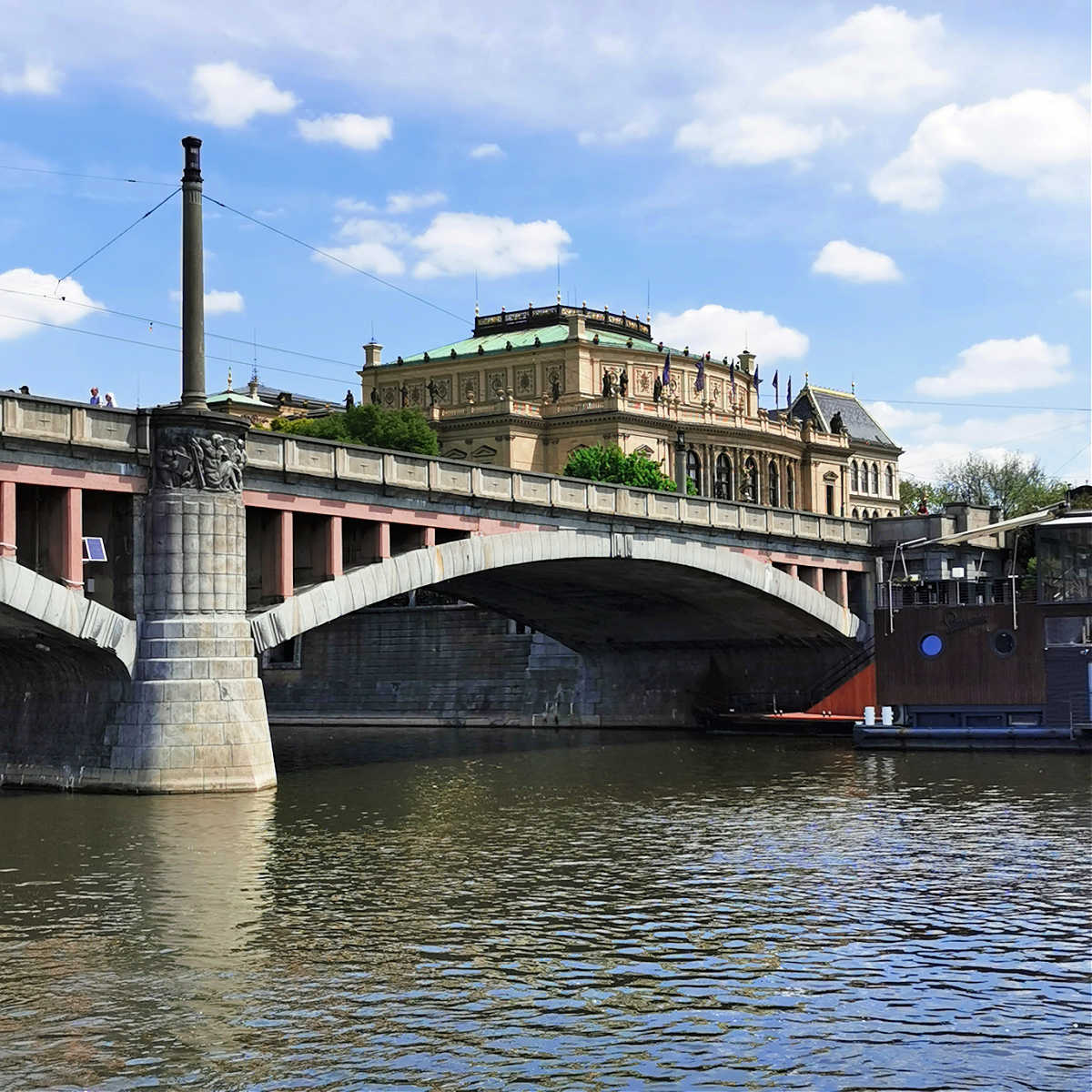
Manes Bridge
Manes Bridge connects Old Town Square access on one side with Prague Castle. Trams no 18, 2 and others travel across and you can use it if you want to walk from Old Town Square to Prague Castle (accessing the castle by the old stairs) leaving out the Kings route via Charles Bridge and Lesser Town Square (and access to the caste via Nerudova Street, for example).
The bridge was built in 1914 as the nearby Charles Bridge become too busy and couldn’t cope with the traffic (at the time Charles Bridge was used by not only pedestrians but also by cars and trams!)
The bridge is named after a famous Czech painter – Josef Manes.

Cech’s Bridge
You can get to Cech’s Bridge from the Old Town Square, pass the Jewish Quarter and it will take you across the Vltava River to exactly where (above) the old Stalin Statue used to stand in the Letna Park. Now it’s a great place to climb up to and view Prague and all the central bridges across the Vltava river.
The Cech’s bridge was built between 1905-1908 and its construction was at the time quite challenging. Because the river is quite fast in that area, the bridge support pillars had to be designed and built with slightly different dimensions to withstand the river flow.
If you look closely, you might be able to see that the width of the arches is growing from about 47 m to 59 m as they span across the river. The rest of the bridge support was also calibrated differently depending on the resistance and the strength of the river flow in each part of the river.
Cech’s Bridge is the only bridge in Prague that is built purely from steel.
Stefanik’s Bridge
This is a modern wide bridge which is always very busy with cars, trams, but only a few pedestrians use it. It was built in the 1950’s and whilst it connects both sides of Vltava river is also directly linked to the Letna car tunnel.
If you walk toward the Vltava river from Republic Square where the Paladium Shopping centre is located and the more traditional Kotva department store, you will get to the Stefanik’s Bridge, which will take you to the bottom of Letna Park.
You can also take the number 15 or 6 and other trams across if you don’t fancy the walk.
Hlavka’s Bridge
Unlike most of the other Prague bridges, Hlavka’s Bridge was never renamed and kept its name right from the beginning when it was built in 1910.
The Hlávek Bridge is the widest bridge in the Czech Republic and the first concrete bridge to cross the Vltava River in Prague.
The construction of the Central Slaughterhouse in Holešovice between 1890-94 was the initial driving force behind its construction. During the preparations for the bridge’s construction, two different architects’ camps, each represented by different generations of technicians, advocated for different materials. While the older generation preferred iron, the younger generation favoured modern concrete. In the end, they decided not to compromise and half of the bridge is built in iron and half with concrete.
The Hlávek Bridge replaced the original wooden bridge and its total width is 16.8 m and its length is 297.4 m. The reason why the architects were able to build the bridge with two different types of material is because there is an island called Stvanice in the middle of the Vltava river.
The shorter part from Těšnov to the island was designed by Ing. Jiří Soukup and architect Mečislav Petrů using steel as the material. The longer part, partially spanning the island of Štvanice and the river, was designed by Ing. František Mencl and architect Pavel Janák using concrete.
The bridge’s artistic decoration includes 2.65 m high reliefs above the island pillars, medallions depicting twelve portraits of town hall representatives who contributed to the bridge’s construction, and sculptures by Jan Štursa named “Práce” ‘Work’ and “Humanita” ‘ Humanitism’.
The bridge was extended (sideways) between 1958 and 1962 to accommodate the planned route of the main road, and the steel part was replaced with a reinforced concrete structure. The bridge is named after Czech architect Josef Hlávek.

Prague bridges outside of the centre
There are of course more bridges over the Vltava river outside the centre of Prague, but you probably won’t see most of these. Towards the Prague 5 and beyond you’d find the Zavodu Miru bridge, Radotin Bridge, Branik Bridge, Barrandov Bridge and Vysehrad Railway Bridge.
Branik Bridge
It’s worth mentioning that the Branik Bridge is also known as the Bridge of Intelligence because when it was being built in the mid 50s the majority of workers were doctors, lawyers, teachers, writers, actors who because of their political views or because there was no need for them in the new communist way of working world, were forced into manual type of jobs, such as builders and labourers. This was the reason why the bridge is called the Bridge of Intelligence.
The idea of bridging the two sides of Vltava at Branik (and Mala Chuchle on the other side) was already born at the beginning of the 20th century. The first projects were put together in the 1920s but it wasn’t until after the second world war, when the Czech government decided that the newly deployed intelligent labourers need something useful to do. If you can detect sarcasm in my voice, then you’d be right…
As a result of this decision, the work began without the plans being finalised! This is why, the bridge was built for 2 lines of railway and a pedestrian walkway, but only one trackbed of the railway line was actually laid. The bridge was opened in 1964.
Today, the bridge is mainly used for goods trains or when the trains are on diversion from Beroun to Prague.
There is also a green tourist path that you can follow from Branik to Mala Chuchle and beyond.

Vysehrad Bridge
This railway bridge connects the Prague districts of Vyšehrad (Výtoň) and Smíchov. It is mainly used for railway transport, but pedestrians can also walk across via footbridges which are on both sides. It’s quite an experience when you are on the bridge and the train is going by, but you get a great view of Vysehrad on one side and Naplavka and Smichov on the other side.
The Vysehrad railway bridge was built in 1901 based on the design of the Prášil Brothers company. It replaced an older bridge structure from 1871 made of welded iron, which, unfortunately, wasn’t very strong.
The building of the bridge was fairly novel at the time. First of all the new bridge pillars were built and secured into the Vltava river bed. The rest of the iron bridge parts were made off site in an iron factory. Once everything was ready, it took only two days to assemble the bridge.
Recently Vyšehrad Bridge future was in danger as Prague Council decided to pull it down and built a new modern bridge. Fortunately, the opposition was so strong, that the bridge was saved and it’s going to be refurbished instead.
The reconstruction should begin in 2026, last for 20 months, and cost an estimated two billion Czech crowns.
What to see around
- Naplavka Farmer’s Market on Saturdays
- Ice-cream Parlour (Pure Gelato) & Vine Bar in the little square opposite Naplavka
- Vysehrad Castle Grounds
- Cubism-style houses (private)
Toward the opposite part of Prague – towards Prague 6 and beyond, you can also find the Negrelli Railway Viadukt (which is used by trains travelling from Masarykovo Train Station – one of the main three train stations in Prague) , Liben Bridge, Holesovice Railway Bridge and Troja Bridge
Negrelli Railway Viadukt
The Negrelli Viaduct connects Masarykovo train station in Prague across the Štvanice Island with Bubny. It is historically the first railway bridge over the Vltava River in Prague and also the second oldest bridge over the Vltava River in Prague.
Negrelli Viadukt is also the longest railway bridge in the Czech Republic measuring just over 1,110 meters and has 87 supporting arches.
The Negrelli bridge was built from 1846 to 1849 and opened to the first train in June 1850. Until the beginning of the 20th century, it was the longest railway bridge in Europe.
In the 1970s, a 351-metre-long connecting viaduct was added to the main branch from Bubny to today’s Masarykovo train station, allowing a direct connection from Bubny to Libeň.
Over the years, there have been many modifications and repairs to the bridge. In 2002, the bridge managed to survive the large August floods which damaged most of the Karlin area under the bridge.
The spaces under the arches of the bridges, especially in the Karlin area, have been gradually walled up, partitioned, or equipped with built-in floors and used for various purposes, such as storage rooms, garages, and various facilities. Several arches are also used for the nearby Florenc bus station – the main bus station in Prague.
The bridge was completely rebuilt and updated from 2017 to 2020 and you can see it now gleaming with clean sandstone bricks.
You can access the Negrelli Viaduct by train only, but you can see the beautiful structure when you take a walk around Karlin area from Florenc Underground Train Station (line B) or tram stop of the same name. My favourite vegan ice-cream shop (Imaginarni Zmrzlina) is just in the street next to the viaduct and you can continue to the Karlin Kasarna, which is an art and culture hub set in the old army barracks.
What to see around
- Karlin district with independent shops, farmer’s markets etc.
- Ice-cream parlour – Imaginarni Zmrzlina and Svetozor
- Karlin Kasarna

Troja Bridge
The Troja Footbridge is a steel footbridge over the Vltava River between the Prague district of Troja and Císařský Island. It’s built for pedestrians and cyclists only, making it easier for everyone to travel from the large Stromovka Park to Troja Zoo, Troja Chateau or the Prague’s largest botanical garden and back.
The current bridge, which is 256 metres long, was opened in 2020 and replaced a footbridge that collapsed in December 2017, which was originally built in 1984.
The first provisional crossing was created in 1977 after a major flood that took away the original river ferry. The small bridge was swept away by another flood in the early 1980s.
I often use the Troja Bridge to cross the river from Stromovka to Troja and think, it’s a much nicer way to get there than to use the underground and bus. Once you are on the Troja side, you can continue walking along the Vltava river either away from Prague or towards Prague – there are cycle and inline skate paths and the paths are easy to walk on and road traffic free.
What to see around
- Stromovka Park
- Troja Chatteau Art Galery
- Prague ZOO – Complete Guide to Prague ZOO >>
- Botanical Garden & Fata Morgana Greenhouse
This blog post was originally written on 22 March 2022 and last updated on 7 July 2023
PIN TO KEEP FOR LATER

